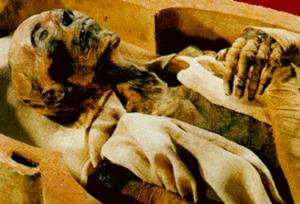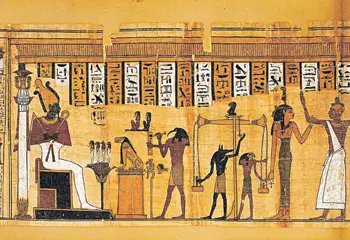Egyptian civilization was a highly religious centered one. The complex and elaborate belief in an afterlife was the part and parcel of Egyptian religious life (Egyptian Afterlife Beliefs and Rituals). The belief in the rebirth after death became their driving force behind their funeral practices. They did not see death as an end, but only as a temporary interruption of life.
 The afterlife was a place of complete bliss, delight, and peace (Egyptian Afterlife Beliefs and Rituals). The Afterlife was referred to as the Field of Rushes or Field of Offerings. Evidence on their beliefs about the afterlife can be obtained from paintings and decorations on the tomb walls. Eternal life could be ensured by means like piety to the gods, mummification and the provision of statutory and other funerary equipment.
The afterlife was a place of complete bliss, delight, and peace (Egyptian Afterlife Beliefs and Rituals). The Afterlife was referred to as the Field of Rushes or Field of Offerings. Evidence on their beliefs about the afterlife can be obtained from paintings and decorations on the tomb walls. Eternal life could be ensured by means like piety to the gods, mummification and the provision of statutory and other funerary equipment.
Each pyramid consisted of an inner chamber that entombed the deceased, the servants of the deceased, and artifacts to make living in the afterlife similar to what they were used to every day. The belief in an afterlife (Egyptian Afterlife Beliefs and Rituals) necessitated the preservation of equipment in the tomb of the deceased.
Egyptians put all the things in the tombs including jewelry, furniture, clothes, knives, spoons, cosmetics, ornaments, statues, and tools. Some tombs which had treasures were often stolen. They made drawings of items which were too big to fit in the tombs. Servants, horses, and pets were buried with the deceased. Whether they were buried alive, is debated.

The ancient world of the underworld is Osiris. Each human consisted of the physical body, the ka, the ba and the akh. It was to the ka that all offerings of food and material possessions were made. Ba or soul was an intangible essence, associated with breath.
Each person also had a ren, or name, which could acquire a separate existence and was once the underlying substance of all one’s integral aspects. Other facets include the khu, or intelligence; the ab, or heart; the sakkem, or life force; the khaybet, or shadow; the ikh, or glorified spirit; and the Sahu, or mummy. Only on the sustained protection of these elements, could afterlife be enjoyed?
After undertaking the perilous journey through the underworld the deceased would face his day of judgment at the Hall of the Two Truths. The jackal god of the dead, Anubis, would lead the dead to the Hall of Two Truths, where the deceased would stand in front of forty-two judges and gods.
The deceased was led to a set of scales where his or her heart, containing the deeds of their lifetime, was weighed against the feather of truth, which symbolized Maat the goddess of justice. The fate of the deceased would then be decided – either entrance into the perfect afterlife or to be sent to the Devourer of the Dead – the Great Swallower.
Canopic jars played an important role in the funeral rituals of Egyptians. The internal soft organs like the intestines, the liver, the stomach and the lungs were removed and placed in separate jars. The lids of these jars represented the four sons of Horus. The heart was not removed as it had to be weighed by the gods in the afterlife. The jars were normally buried together but kept separate from the mummified body.